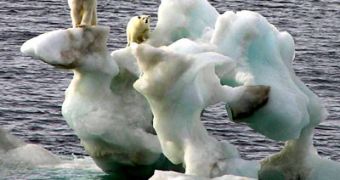The Northern Hemisphere is warmer.
That's because there are more land masses, that trap more heat during the summer.
That's why ice packs on the North Pole are more sensitive to the global warming and it would shrink faster at minimal temperature changes, unlike the Antarctic ice, which is much more stable.
That's why all prognoses and climate model predictions have said that between 2050 to 2100, Arctic summers will see no ice on the sea for the first time in the last one million years.
But the field researches contradict the computer simulations: the ice has been melting in fact about 3 times quicker than the models have found, bringing total meltdown 30 years earlier. Computer-made models of the global climate forecasts from the Intergovernmental Panel on Climate Change (IPCC) employ mathematical equations for the greenhouse gas levels.
To find future trends, the models begin with a given year in the past, like 1800, and modulate forward in time. But these simulations made using real-world observations do not capture small fluctuations of actors that seem minor but which actually aren't, such as the ocean heat and ice thickness, factors that can decrease significantly the sea ice pack.
A team led by climatologist Julienne Stroeve of the National Snow and Ice Data Center at the University of Colorado, Boulder, double-checked the IPCC projections with melting records of the ice, gathered by aircraft and ship reports and satellite measurements.
While the computer models found ice losses in September (the year's period when ice retreats is at its minimum) at 2.5% at each 10 years for the interval 1953 to 2006, in reality the value was of roughly 7.8%, thus summer ice is melting much faster than previously thought. "One reason global climate models lowball the rate of melting is that they underestimate the amount of heat transported into the Arctic from the Atlantic Ocean and Bering Sea, which affects the rate of sea ice melting", said Arctic modeler Wieslaw Maslowski, of the Naval Postgraduate School in Monterey, California.

 14 DAY TRIAL //
14 DAY TRIAL //